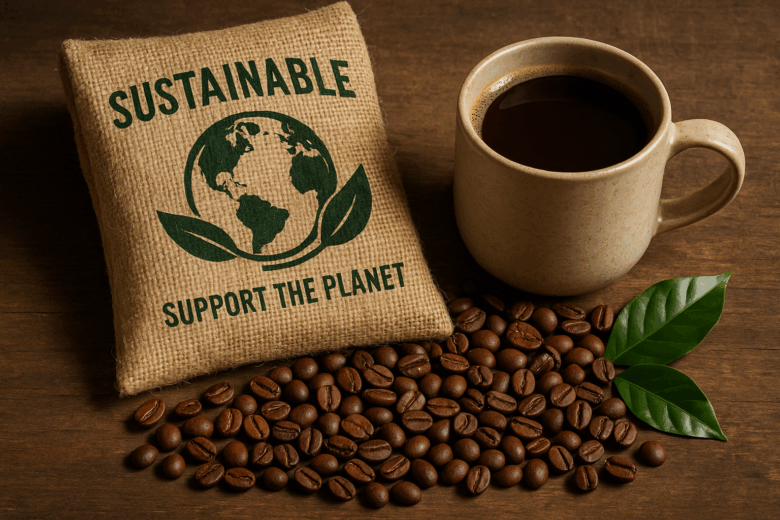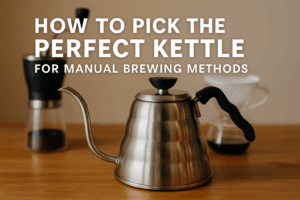Your daily cup of coffee might be more than just a caffeine fix — it can also be a small but powerful act of environmental responsibility.
As climate change intensifies and agricultural industries expand, consumers are becoming more conscious of the environmental and ethical footprint of their purchases. Coffee is no exception.
But with so many labels, certifications, and claims out there, how can you really tell if your coffee is sustainable?
In this article, you’ll learn what makes coffee environmentally and socially responsible, how to recognize the signs of greenwashing, and how to choose brands that truly support the planet.
What Does “Sustainable Coffee” Really Mean?
Sustainable coffee refers to coffee that is grown, processed, and sold in ways that are environmentally sound, socially responsible, and economically viable.
It’s not just about planting a few trees or using organic fertilizer. A truly sustainable coffee supply chain protects biodiversity, uses water responsibly, minimizes carbon emissions, supports fair labor, and builds strong farming communities.
In general, a sustainable coffee brand considers three major pillars:
- Environmental sustainability: conserving ecosystems, avoiding deforestation, and reducing pollution
- Social responsibility: protecting workers’ rights, promoting gender equity, and supporting local communities
- Economic sustainability: ensuring that farmers and workers receive fair compensation and have long-term business stability
The Environmental Impact of Conventional Coffee
Coffee is one of the most traded commodities in the world, and high demand has often led to harmful agricultural practices, especially in industrial-scale production.
Traditional sun-grown coffee — where forests are cleared to create large open plantations — contributes to deforestation, biodiversity loss, and soil degradation. Pesticides and chemical fertilizers contaminate local water sources and harm wildlife. Plus, large farms often use inefficient irrigation systems, wasting precious freshwater.
Additionally, the global coffee supply chain involves significant transportation and packaging, leading to a high carbon footprint if not managed responsibly.
Choosing sustainable coffee helps counter these negative effects by supporting producers who work in harmony with nature rather than against it.
Common Sustainability Certifications (and What They Mean)
One of the easiest ways to find environmentally responsible coffee is to look for certifications. But not all certifications are created equal. Here’s a breakdown of some of the most common ones:
Fair Trade Certified
- Focus: Fair wages, safe working conditions, and community development
- Includes some environmental standards, but primarily a social certification
- Supports small-scale producers by ensuring minimum prices and direct trade
USDA Organic
- Focus: No synthetic pesticides or fertilizers
- Encourages soil health, crop rotation, and natural pest control
- Does not necessarily guarantee fair labor conditions
Rainforest Alliance Certified
- Focus: Combines environmental, social, and economic goals
- Requires farms to protect forests, improve livelihoods, and use sustainable farming practices
- More flexible than some other certifications but still meaningful
Bird Friendly (Smithsonian Migratory Bird Center)
- Focus: Shade-grown coffee that supports bird habitats
- Requires farms to meet strict criteria for tree canopy coverage, biodiversity, and organic farming
- Often found on coffees from Latin America
Carbon Neutral or Climate Positive
- Focus: Reducing or offsetting the carbon emissions of production and transport
- Labels may vary by country or independent certification body
- Not always verified by third parties, so check the brand’s transparency
Remember: a single certification doesn’t tell the whole story. The best sustainable brands go beyond minimum requirements and provide full transparency about their practices.
Shade-Grown vs. Sun-Grown Coffee
One major environmental factor is whether your coffee is shade-grown or sun-grown.
Shade-grown coffee is cultivated under the canopy of trees, mimicking the plant’s natural environment. This method:
- Preserves native forests and animal habitats
- Reduces the need for chemical inputs
- Protects soil and water quality
- Provides additional income sources for farmers (like timber or fruit)
In contrast, sun-grown coffee maximizes yield at the expense of biodiversity and ecological balance. It requires more fertilizer, irrigation, and pest control — and often results in lower cup quality.
Look for packaging that mentions “shade-grown” or includes certifications that support biodiversity, such as Bird Friendly.
Direct Trade and Transparent Sourcing
Another hallmark of a sustainable coffee brand is how it sources its beans.
Direct trade is when coffee roasters work directly with farmers or cooperatives, cutting out intermediaries and ensuring more profit reaches the producers. This model often leads to:
- Better traceability and quality control
- Long-term relationships between roasters and farmers
- Higher prices paid to farmers (often above Fair Trade minimums)
Some brands go a step further by providing full transparency — sharing information about farm locations, processing methods, and even profit distribution.
When researching a brand, look for sourcing details on their website or packaging. If they’re vague about origins, it might be a red flag.
Sustainable Packaging and Carbon Footprint
Coffee packaging plays a major role in sustainability. Look for brands that use:
- Compostable or recyclable bags
- Biodegradable one-way valves
- Refill systems or bulk bins (at local cafés or grocery stores)
Also, consider where the coffee is roasted. Beans grown in Africa but roasted in Europe and then sold in the U.S. have a much higher carbon footprint than coffee roasted closer to its point of sale.
Some companies now offset emissions through carbon credits or invest in reforestation projects to become carbon-neutral or climate-positive.
How to Spot Greenwashing
Unfortunately, not all “eco-friendly” claims are honest. Many brands use buzzwords like “sustainable,” “natural,” or “eco-conscious” without clear evidence to back them up.
Here are a few tips to avoid greenwashing:
- Look for specifics: Does the brand explain exactly what makes their coffee sustainable?
- Check for certifications: Are they backed by third parties or just using self-made logos?
- Investigate the supply chain: Do they mention farm names, locations, or direct relationships?
- Avoid vague claims: “Better for the planet” means nothing without details
If a company is truly committed to sustainability, they’ll be proud to share the numbers, processes, and people behind their coffee.
Brands Known for Sustainability
Here are a few coffee brands with strong sustainability credentials (always check their most recent updates for transparency):
- Counter Culture Coffee (USA): Shares detailed sustainability reports and farm relationships
- Allegro Coffee (USA): Certified organic, fair trade, and zero-waste roasting facilities
- Equal Exchange (Global): Worker-owned cooperative focused on fair trade and small-scale farmers
- Café Mam (Mexico): 100% organic and shade-grown, with a mission to support Indigenous communities
- Small batch roasters in your local area: Many independent roasters prioritize sustainability and transparency
Simple Tips to Make Your Coffee Routine More Sustainable
You don’t need to change everything overnight. Here are small actions that make a big difference:
- Buy whole bean coffee to avoid waste and extend shelf life
- Grind only what you need to keep coffee fresher and reduce overuse
- Use a reusable filter or French press instead of disposable pods
- Compost your coffee grounds or use them in your garden
- Support cafés that source responsibly and offer discounts for bringing your own cup
Why It Matters
Sustainability isn’t just a trend — it’s a necessity. Coffee is grown by millions of farmers, often in regions most vulnerable to climate change, deforestation, and economic instability.
Your choices can help shift the industry toward more ethical and environmentally sound practices. By supporting responsible brands and rethinking daily habits, you’re investing in a future where coffee remains not just available — but better, fairer, and more resilient.
Because when your coffee supports the planet, it tastes a little better too.



